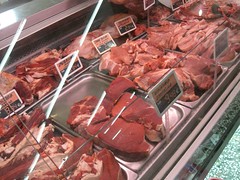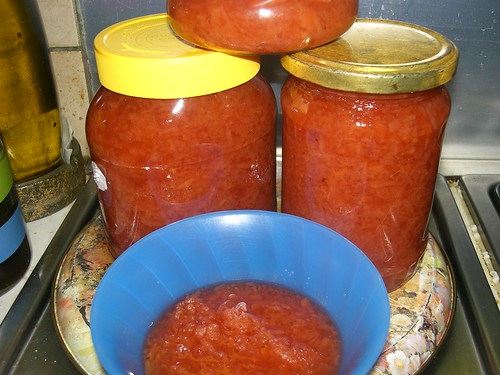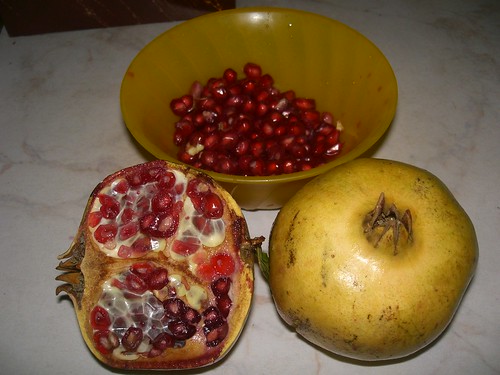Here's a selection of in-season fruit in Hania, each one with a strange exotic appearance and taste. Each one is unique, and although they are considered by some to be old-fashioned fruits, they have their own unique uses in the kitchen. They can also act as a talking point; put them in a bowl on your coffee table and they will easily replace the classic coffee table book, sparking interest by their own very unique roles in the history of the ancient world.
 These autumn fruits are all being sold at the street market now: yellow quince, orange persimmon and crimson-yellow pomegranate.
These autumn fruits are all being sold at the street market now: yellow quince, orange persimmon and crimson-yellow pomegranate.Pomegranate is one of my favorite autumn fruits. I was given these ones by
an aunt. Its sweet, tasty flavour, in combination with the stunning colour of the fruit, make this comestible a beauty queen. Pomegranate has a lovely round shape, with a characteristic star-like cone at the tip. On opening the fruit, you will be surprised to find that it contains juicy red seeds. This is what is eaten from the pomegranate; the seeds are scooped out with a spoon, while the skin is discarded - it's as tough as leather. It makes a beautiful addition to a winter fruit basket. It has a beautiful name in Greek: ρόδι -
rodi (in Crete, we also call it
rogdi)
- a derivative of the word 'ρόδο', meaning 'rose', referring to its shape, the colour of the fruit, its smell, or all of these.
One of my favorite stories from ancient Greek mythology involves the pomegranate. Despite their positive attributes, pomegranates carry negative connotations in ancient Greek culture.
Persephone, daughter of the goddess of fertility and agriculture, Demeter, ate some pomegranate while she was living with Hades in the underworld, which is how the seasons are explained in Greek mythology: she ate six (no one really knows if she ate six seeds or six pomegranates), which is why we have six cold months and six warm months every year. During the spring and summer, Persephone is living above ground with her mother Demeter, while in the autumn and winter, she's underground keeping Hades company. Demeter is overcome with grief, expressing her loss in the bare trees and cold weather. Since pomegranates are so closely associated with the underworld, it is no surprise that
these seeds are added to the boiled wheat cakes (the koliva) that are served after a memorial service held at the Greek Orthodox church for a loved one who has passed away.
The pomegranate has quite a different popular history in Armenia, where it grows in abundance; it is a symbol of joy, representing fertility, abundance and marriage. My Armenian students at the institute where I work tell me that its seeds are added to salads, pressed into a juice, added to a meat marinade, apart from being eaten fresh;
pomegranates are eve turned into a wine. One of my favorite Armenian students was named Anahit. When I saw a box of imported pomegranates at the market bearing the name ANAHITA, I asked her about the history of her name and its relationship with pomegranates. She told me that
Anahita was the Persian goddess of fertility, and is symbolised as holding a pomegranate in her hand; Armenia and the ancient culture of Persia have intertwined histories.
... the bad...

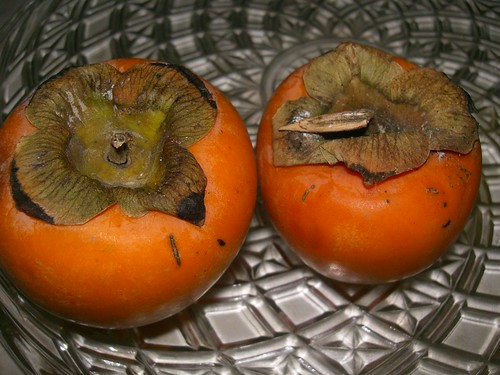
With the appearance of an unripe tomato (both inside and outside), the exotic persimmon, λωτός (lotos as it is called in Greek), is considered a berry (a berry berry large one). If you see them growing on a tree, you'll think they look like luscious apples ready for picking. A bite off one of these, and you'll be searching for a bathroom to wash out their acrid taste. Then you'll start worrying that your tongue has grown furry; really revolting. They really are an acquired taste, something these fruits often seem to lack.
These were given to me by my uncles who gave me some advice about when to eat them. You have to wait until the fruit looks like a soft tomato. If it isn't wholly ripe, red, soft and juicy, it will taste very bitter; it needs to look as though it is rotten. The fruit is often picked before it is mature enough to eat, and ripens on its own over time. When ripe, it is pulpy rather than fleshy.
Its name in Greek sounds like 'lotus', the common name for another exotic fruit, but one that is totally unrelated to the persimmon. So what did the lotus eaters eat when they ate lotus - persimmon, or lotus fruit? Only Odysseus knows the answer to that one. Apparently, this fruit was so delicious, that Odysseus' crew didn't want to leave the island where they found it, and Odysseus nearly never made it back to his beloved Ithaca.
I've come across a lot of persimmon recipes over the internet, the pulp of the fruit being added to soft cookies, cakes, pies and bread. I was touched when I saw a persimmon walnut cake, made by my sinonomati Maria from New York, using persimmons from her uncle's garden who lives in one of the oldest Greek neighbourhoods of New York, Astoria.
Quince is a weird fruit. It's too tough to eat raw, but when cooked, it can be turned into either a sweet, or
as a substitute for potato or
root vegetables in a roast. My mother often made quince spoon sweet in New Zealand, which she bought at the
Tory St Market in Wellington. Believe it or not, despite its ancient links,
quince was growing in New Zealand well before New Zealand was colonised, and the Maori were using it as a food item. During my time in New Zealand, quince was already starting to sound like an old-fashioned fruit, although it is making a big comeback in cuisines all over the world, given the increased attention paid to natural food sources. Quinces looks like a badly formed apple - or maybe an overgrown pear. In its raw form,
it has a hard woody taste. It undergoes an incredible transformation once it is cooked.
Quince is called
κυδώνι 'kydoni' in Greek.
Kydonia was also the name given to Hania in ancient times, a name that still survives in the town, especially in the form of Kydon, the name of a hotel, a TV channel, a sports club, and a whole host of small businesses in the summer resort town of Hania. Quinces were grown in Crete, from where they spread to other areas of ancient Greece, taking the name with them for this unusual fruit.
The 'apple' that Paris gave to the ancient Greek goddess of love, Aphrodite, might actually have been a quince; in any case, it was enough
to start the Trojan war...
The quinces in the photo were being sold at the market; they are not as ugly as the ones I have seen growing on trees in the village. Their shape is usually asymmetrical, they have rough patches on their skin, and
they also seem to have a dusty grey fur covering their skin. So why did I call it an ugly fruit? It's a bit like the ugly duckling. This yellow-on-the-outside, creamy-white-on-the-inside fruit turns a muddy brown as soon it is sliced through, like an apple. As it starts to cook, it seems to become bleached white, turning different shades the longer it cooks, uintil it becomes Cinderella pink. When sliced through - if your quince is slightly unripe, you'll need a good knife and a lot of patience to peel them - it exudes a sweet aroma; quinces have even been known to be
used as air fresheners!
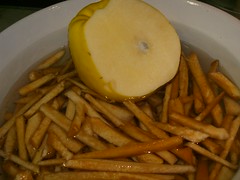
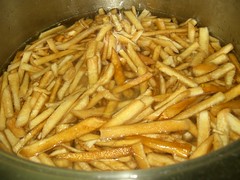
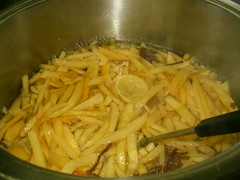
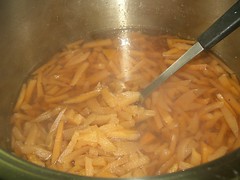
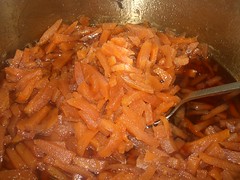
 (watch the muddy quince bleaching and blushing as it darkens while it is cooked)
(watch the muddy quince bleaching and blushing as it darkens while it is cooked) 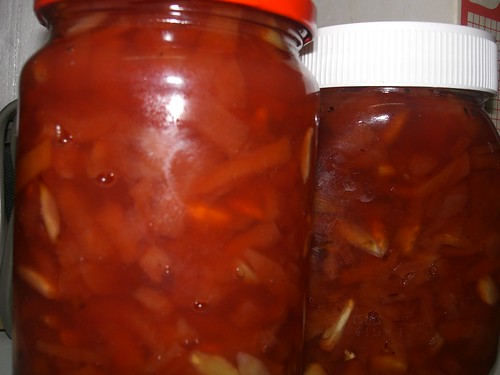
(I made this quince sweet using Nancy's recipe, which resembles my mother's method to cook quince; Nancy also details another recipe for grated quince. They are very similar to each other, and equally delicious.) Whenever I see quince, whether it's at the market or on the fruit trees in the village fields, I always remember my mother turning it into a spoon sweet, and the unforgettable aroma that filled our New Zealand kitchen when she cooked it. Spoon sweets are old-fashioned syrupy fruits, served on a dainty plate with a glass of water, maybe after a cup of Greek coffee, to lighten the palate of its bitter flavour. This whole synthesis is brought out on a silver tray lined with a quaint crocheted doily. Most people have done away with unnecessary furnishings and textiles in their hoses these days, but you can still see this tradition continued in the houses of senior citizens, whose velvet armchairs still carry an anti-macassar on their backs; don't forget the set of three nesting tables to keep the offerings close to the guest!
There is still a place for spoon desserts in our times. They are often served at the end of the meal in tavernas, sprinkled over strained Greek yoghurt. This makes a fantastic end-of-dinner dessert, much lighter than ice-cream, since spoon desserts contain no fat, and the yoghurt is usually not sweetened. Quince spoon sweet is also a perfect dessert for Christmas, with its pinky-red hues. Serve it with a spoon sweet fig, and you're looking at Christmas on a plate. And if you do want to make it in time for Christmas (which, my children keep telling me, is only a month away), you'll have something ready to serve on the day with trifle, ice-cream, pudding or yoghurt.
This is my entry for this week's
Weekend herb Blogging, hosted this week by
Scott from
The Real Epicurean.
©All Rights Reserved/Organically cooked. No part of this blog may be reproduced and/or copied by any means without prior consent from Maria Verivaki.






